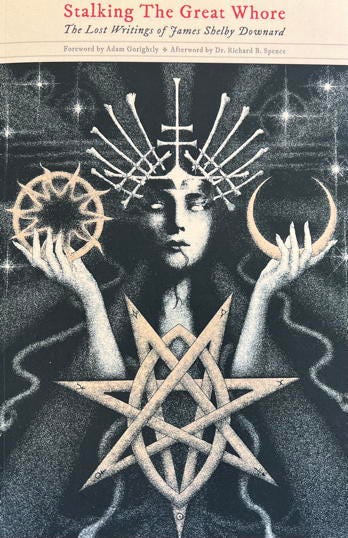Book Review
STRANGER THAN WE CAN IMAGINE
Stalking the Great Whore: The Lost Writings of James Shelby Downard
Foreword by Adam Gorightly. Afterword by Dr. Richard B. Spence. 479 pages. Softcover. Illustrated. 2023.
Reviewed by Michael Hoffman • Revisionist History Website
Our “library angel” remains as active as ever. Monday, February 28, this writer was interviewed on the crrow777radio program for two hours. In the first hour the eponymous host inquired about James Shelby Downward (1912-1998; the 111th anniversary of his birth is Sunday, March 12). To our complete surprise, that afternoon at around 3 p.m., the post office delivered Stalking the Great Whore, consisting of extensive material by our late friend, mentor and collaborator which was believed lost until discovered on microfiche in 2015.
Somewhere Shelby is smiling. We certainly are. We’re grateful that interest in his work is abiding.
He opens this autobiography with the words, “I walked ‘the crooked mile’ as a straight man.”
Later he writes, “I sure as hell know about the Sorcerers, and I intend to inform the Hoodwinked public as to what is going on!”
University of Idaho Prof. Richard B. Spence’s biographical afterword is an important contribution. He did yeoman work in the archives and it is free of spin. He keeps an open mind and demonstrates from numerous records that James Shelby Downard’s life, which critics have regarded as too preposterous to credit, was, to borrow a phrase from J.B.S. Haldane, stranger than we can imagine. Something similar was said of Downard’s research by his colleague Jim Brandon, who termed his take on the JFK King-Kill, the “farthest-out brain wave of assassinology yet.” Spence himself writes, “in a realm where the bizarro-meter is set pretty high, Downard goes straight to ‘11.” (What gaps there are in Dr. Spence’s biographical sketch are perhaps mainly due to him having chosen not to interview people who knew Shelby).
At long last Mr. Downard gets his due (!) in the wake of the less than stellar redacted Feral House version/edition of Shelby’s Carnivals of Life and Death, which was published without context —without apparatus that would indicate via marginalia or notes, those sections which were poetic expressions, or attempts at satire and jesting. For instance, on p. 12 of Stalking the Great Whore, after stating that some of his enemies think he may be protected by “the so-called demon Azazel,” he jokes: “…it’s nice to have friends and I welcome any and all help.” When Leon Trotsky offers to make him immortal (p. 57), Downard replies, “No, thanks Mr. Trotsky, all the immortals I know about are dead.”
Poète maudit and Scapegoat
The defiant jibe was his tried-and-true means of attempting to spook the spooks by demonstrating his insouciance and Biercean satire (on more than a few of Shelby’s envelopes containing letters which he mailed to correspondents was an ink-stamped quote from Ambrose Bierce’s The Devil’s Dictionary, “My country ’tis of thee, sweet land of felony”).
James Shelby Downard was a poète maudit in the line of Antonin Artaud and all those who comprise, in the words of Alfred de Vigny, “la race toujours maudite par les puissants de la terre”—the race that will always be cursed by the powerful ones of the earth.
Keep reading with a 7-day free trial
Subscribe to Michael Hoffman's Revelation of the Method to keep reading this post and get 7 days of free access to the full post archives.




